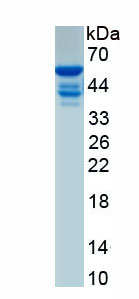Recombinant Troponin T Type 2, Cardiac (TNNT2)
CMH2; cTnT; TnTc; Cardiomyopathy,Hypertrophic 2; Cardiac muscle troponin T
- Product No.RPD232Hu02
- Organism SpeciesHomo sapiens (Human) Same name, Different species.
- SourceProkaryotic expression
- HostE.coli
- Endotoxin Level<1.0EU per 1µg (determined by the LAL method)
- Subcellular LocationCytoplasm
- Predicted Molecular Mass56.0kDa
- Accurate Molecular Mass56kDa(Analysis of differences refer to the manual)
- Residues & TagsMet1~Lys295 with His and TRxA Tag
- Buffer FormulationPBS, pH7.4, containing 0.01% SKL, 5% Trehalose.
- Traits Freeze-dried powder
- Purity> 80%
- Isoelectric Point4.6
-
Applications
Positive Control; Immunogen; SDS-PAGE; WB.
If bio-activity of the protein is needed, please check active protein. - DownloadInstruction Manual
- UOM 10µg50µg 200µg 1mg 5mg
- FOB
US$ 184
US$ 460
US$ 920
US$ 2760
US$ 6900
For more details, please contact local distributors!
SEQUENCE

USAGE
Reconstitute in ddH2O to a concentration of 0.1-0.5 mg/mL. Do not vortex.
STORAGE
Avoid repeated freeze/thaw cycles. Store at 2-8°C for one month. Aliquot and store at -80°C for 12 months.
STABILITY
The thermal stability is described by the loss rate. The loss rate was determined by accelerated thermal degradation test, that is, incubate the protein at 37°C for 48h, and no obvious degradation and precipitation were observed. The loss rate is less than 5% within the expiration date under appropriate storage condition.
GIVEAWAYS
INCREMENT SERVICES
-
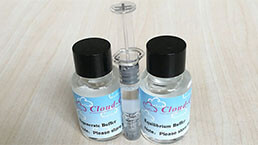 Endotoxin Removal Kit
Endotoxin Removal Kit
-
 BCA Protein Quantification Kit
BCA Protein Quantification Kit
-
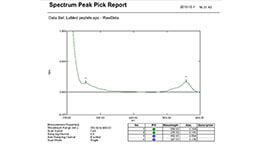 Protein Labeling Customized Service
Protein Labeling Customized Service
-
 Molecular Mass Marker for Protein
Molecular Mass Marker for Protein
-
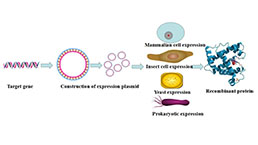 Recombinant Protein Customized Service
Recombinant Protein Customized Service
-
 Monoclonal Antibody Customized Service
Monoclonal Antibody Customized Service
-
 Polyclonal Antibody Customized Service
Polyclonal Antibody Customized Service
-
 Protein Activity Test Experiment Service
Protein Activity Test Experiment Service
-
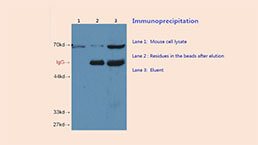 Immunoprecipitation (IP) Experiment Service
Immunoprecipitation (IP) Experiment Service
-
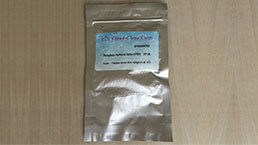 Buffer
Buffer
-
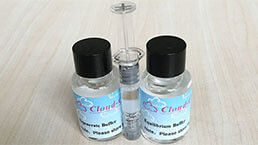 Endotoxin Removal Kit II
Endotoxin Removal Kit II
-
 Real Time PCR Experimental Service
Real Time PCR Experimental Service
-
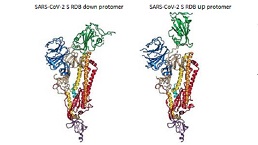 Spike RBD Protein (S-RBD)
Spike RBD Protein (S-RBD)
-
 Protein G
Protein G
-
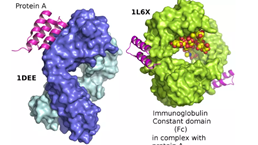 Protein A
Protein A
| Magazine | Citations |
| Basic & Clinical Pharmacology & Toxicology | Cardioprotective Effect of Sulphonated Formononetin on Acute Myocardial Infarction in Rats PubMed: 21232020 |
| Basic & Clinical Pharmacology & Toxicology | Cardioprotective Effect of SMND-309, A Novel Derivate of Salvianolic Acid B on Acute Myocardial Infarction in Rats Wiley: source |
| European Journal of Pharmacology | Protective roles of Asperosaponin VI, a triterpene saponin isolated from Dipsacus asper Wall on acute myocardial infarction in rats ScienceDirect: S0014299909009984 |
| Journal of translational medicine | The altered expression profile of microRNAs in cardiopulmonary bypass canine models and the effects of mir-499 on myocardial ischemic reperfusion injury PubMed: PMC3694448 |
| Oral Diseases | Salivary high‐sensitivity cardiac troponin T levels in patients with acute myocardial infarction Pubmed: 22834943 |
| An International Journal of Pharmaceutical Sciences | In vivo and in vitro cardioprotective effects of Panax quinquefolium 20 (S)-protopanaxadiol saponins (PQDS), isolated from Panax quinquefolium Pubmed: 23700796 |
| Journal of Animal and Feed Sciences, | The effects of caloric restriction and age on thyroid hormone signalling in the heart of rats Pl:Source |
| Liver Int. | Cardiomyopathy reverses with recovery of liver injury, cholestasis and cholanemia in mouse model of biliary fibrosis Pubmed:24330504 |
| Cardiovasc Toxicol. | Cardioprotective Effect of Rhizomes of Acorus gramineus Against Isoproterenol-Induced Cardiac Damage in Pigs Pubmed:24420420 |
| British Journal of Pharmacology | Glutathione administration reduces mitochondrial damage and shifts cell death from necrosis to apoptosis in ageing diabetic mice hearts during exercise Pubmed:25039894 |
| Chemico-Biological Interactions | Crocin protects against doxorubicin-induced myocardial toxicity in rats through down-reCavia (Guinea pig )lation of inflammatory and apoptic pathways Pubmed:26807765 |
| The Journal of Pharmacology and Experimental Therapeuties | The Cardenolide Glycoside Acovenoside A Affords Protective Activity in Doxorubicin-Induced Cardiotoxicity in Mice Pubmed:27247000 |
| The Journal of Maternal-Fetal & Neonatal Medicine | Troponins, heat shock proteins and glycogen phosphorylase BB in umbilical cord blood of complicated pregnancies. pubmed:27937003 |
| PLoS One. | Outer Balloon Ligation Increases Success Rate of Ischemia-Reperfusion Injury Model in Mice. pubmed:27907155 |
| Biomedicine & Pharmacotherapy | Rosuvastatin improves myocardial and neurological outcomes after asphyxial cardiac arrest and cardiopulmonary resuscitation in rats pubmed:28076830 |
| PLoS One | Imatinib attenuates cardiac fibrosis by inhibiting platelet-derived growth factor receptors activation in isoproterenol induced model pubmed:28570599 |
| EXPERIMENTAL AND THERAPEUTIC MEDICINE | Cardioprotective effect of Notch signaling on the development of myocardial infarction complicated by diabetes mellitus pubmed:29042932 |
| PLoS One | Increases in plasma corin levels following experimental myocardial infarction reflect the severity of ischemic injury Pubmed: 30192780 |
| PLoS One | Tissue suction-mediated gene transfer to the beating heart in mice Pubmed: 32027678 |
| Journal of Human Kinetics | Hormonal Response to Incremental and Continuous Exercise in Cyclists with Left Ventricle Hypertrophy Pubmed: 32148580 |
| BIOMEDICINE & PHARMACOTHERAPY | Chlorogenic acid prevents acute myocardial infarction in rats by reducing inflammatory damage and oxidative stress Pubmed: 33022535 |
| Toxics | Norepinephrine Leads to More Cardiopulmonary Toxicities than Epinephrine by Catecholamine Overdose in Rats Pubmed: 32947820 |
| Elife | Iron derived from autophagy-mediated ferritin degradation induces cardiomyocyte death and heart failure in mice 33526170 |
| Cell Metabolism | Pharmacological inhibition of arachidonate 12-lipoxygenase ameliorates myocardial ischemia-reperfusion injury in multiple species 34536344 |
| Anal Bioanal Chem | Development of a novel ssDNA aptamer targeting cardiac troponin I and its clinical applications 34673993 |
| Experimental and Therapeutic Medicine | Hydrogen therapy after resuscitation improves myocardial injury involving inhibition of autophagy in an asphyxial rat model of cardiac arrest Pubmed:35495584 |


